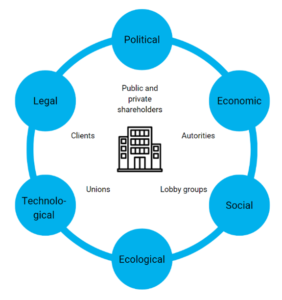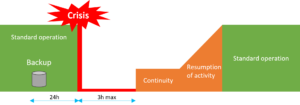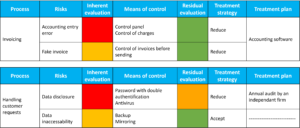Companies face multiple risks: cyberattacks, natural disasters, power outages, etc. These threats are increasingly complex and unpredictable. They can paralyze your operations, lead to significant financial losses, and sometimes even threaten the survival of your company.
This is where the Business Continuity Plan (BCP) comes in, a proactive strategy that allows your business to maintain its essential operations, even in the most critical situations.
How do you develop an effective BCP? What are the key steps? How do you prepare your business to respond to the unexpected?
Discover a method successfully applied with our clients to implement a solid and reliable BCP.

1/ Define the company’s context and the objectives of the BCP
Each company is unique, and understanding its specific context is crucial. For example, use a PESTEL analysis to thoroughly examine the factors influencing your activities. This will help you identify the specifics of your company, its history, its market position, etc.

From this context, you can set objectives for your BCP that are perfectly aligned with the needs of your business.
Here are examples of objectives frequently encountered among our clients:
- Ensure operational resilience => Guarantee 100% availability for essential services
- Minimize financial losses => Reduce financial losses from critical incidents by 20%
- Protect employees and assets => Zero major incidents related to safety
2/ Identify key processes
This step is essential to recognize the operations that are crucial for the functioning and survival of your business in a crisis situation.
Start by creating a comprehensive list of activities performed within your company. From production to customer management, logistics services, and technical support, no activity should be overlooked.
Then for each activity, ask yourself, “What would be the consequences if the activity were interrupted?”. The answers will help you identify the key processes.
3/ Identify assets related to the processes
Assets are the resources necessary for the proper functioning of your processes. Start by making a complete inventory of resources linked to each key process. This may include software, buildings, machinery, data, among others.
Then, evaluate each asset by asking, “Can this process operate without this asset?” If the answer is no, or if the absence of this asset would significantly decrease the quality or efficiency of the process, then that asset should be classified as critical.
4/ Define RTO and RPO
When developing a BCP, it is essential to integrate two key concepts:
- Recovery Time Objective (RTO): This term refers to the maximum allowable downtime to restore a process or system after an interruption. It represents the acceptable duration for which a process can be out of service without causing significant damage to the business.
- Recovery Point Objective (RPO): The RPO defines the maximum amount of data that the business can afford to lose in a crisis. This objective is expressed in terms of time and determines the frequency at which data should be backed up.

In the example above, the crisis situation is the hacking of servers. The RTO is set at a maximum of 3 hours. This means that the systems must be restored within this timeframe after the interruption to avoid major consequences for the business. The RPO, on the other hand, is 24 hours. This implies that data must be backed up at least once a day to ensure that, even in the event of a crisis, data loss does not exceed this timeframe.
5/ Identify and assess risks by scenario
Before starting this step, it is crucial to establish a policy that clearly defines the criteria for identifying and assessing risks.
For each company activity, identify all potential risks. You can organize brainstorming sessions with managers to consider all possible scenarios.
Once risks are identified, analyze their potential impact on activities. It is important to consider the immediate consequences as well as the long-term effects on key processes, assets, employees, and the company’s reputation.
Risk analysis should measure both the severity of the impact and the probability of the event occurring.

6/ Implement control measures
Once risks are assessed, they can be managed using four strategies:
- Avoid: Eliminate risks whenever possible.
- Reduce: Decrease the intensity or probability of risks.
- Transfer or share: Spread risks with third parties, for example through insurance or partnerships.
- Accept: Recognize some risks as inevitable and assume them.
It is not necessary to produce a multitude of documents that will remain unused. The important thing is to wisely choose the actions to implement. Develop specific procedures, controls, and regulations to effectively mitigate the identified risks.

The matrix above (from the Optimiso Suite risk management software) allows you to see at a glance all the elements of our risks: the gross and net evaluation, the control measures, and the management strategy. The mapping can also assist you in daily risk management.
7/ Identify and conduct tests
Once your Business Continuity Plan (BCP) is established, it is essential to test it regularly to ensure its effectiveness. Here are the key steps to identify and conduct these tests effectively:
a/ Test planning
To start, identify the types of tests most suited to your BCP, based on the processes and risks already identified. These could be simulations, quizzes, or practical exercises under real conditions.
b/ Defining objectives
For each test, identify clear and measurable objectives.
Do you want to check employees’ understanding of the plan, test the effectiveness of emergency procedures, or evaluate the computer systems’ ability to recover after a failure? These objectives will help you measure the effectiveness of the test and identify necessary improvements.
c/ Conducting the tests
Next, you can organize and conduct the tests according to the established schedule. It’s important that participants take the tests seriously and act as if they were responding to a real emergency.
All information such as response times or actions taken must be documented. They will serve as proof in case of an audit.
d/ Analysis and review
After each test, the results should be analyzed to determine if the objectives have been met and to identify any difficulties. This review process is essential to strengthen the ability to manage crises. Consider also writing a report of each test for management or auditors.
8/ Maintenance and optimization of the BCP
Your Business Continuity Plan (BCP) is now operational. To ensure its continued effectiveness, it is essential to maintain it regularly by performing the following actions:
- Conduct tests across different scopes
- Reassess the risks
- Update the documentation
- Monitor indicators related to the BCP
- Track incidents and action plans
- To go further: obtain ISO 22301 certification

Software like Optimiso Suite can greatly facilitate this maintenance. It assists you by automating controls, documentary updates, and tests, in addition to alerting you to any need for updates. Let the software handle the repetitive tasks while you focus on the strategic aspects of your BCP.
The 8 steps described above effectively structure the implementation of your Business Continuity Plan. By following them, you will maximize the benefits of your BCP, ensuring optimal preparation for your staff and management, and guaranteeing a quick and effective recovery of your activities in case of a crisis.
